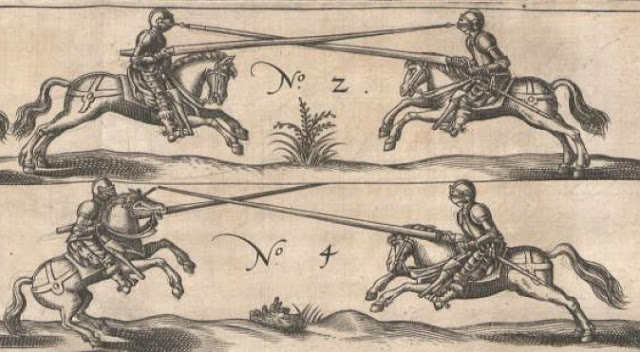Featured
- Get link
- X
- Other Apps
HEAD POSITION DURING CARRIERA / CHARGE
In every treatise from the 16th-17th century, great emphasis is placed on learning to hold the horse's head steadily and in the right position.
Anonym in „Gospodarstwo” (1600) wrote:
„gdyż to najpierwsza sztuka, głowę koniowi do kształtnego trzymania przywieść; aby ją ani wzgórę wspierał, ani ku dołowi wodza porywał…”[1]
“Because this is the first important art to bring the horse's head to be held neatly; so as not to raise, nor lower it with the reins ... "
Such position of the head had, apart from easier driving the horse, also combat use.
Robert Ward in 1639 mentions to watch out for:
„Thirdly, in his performance against an enemie, he shall be able to execute, or suffer more with his forehead, than can be expected from his Mussell, being the tendrest part of him.”[2]
Robert Ward explains that the horse would better receive a random blow to the forehead than to the "mussell", which is the most tender part of him.
However, it is Pasqual Caracciolo in "La gloria del cavallo" (1566) on page 346, who explains in detail what an important exercise this exercise can do, and what the curb bit was also used for and how to choose it appropriately [3]:
„Certainly, very short curb bit are comfortable for the horse
to drink in any stream, but on the other hand they make him unsure on the mouth and head; because when it comes to collide with an enemy, and[the horse] receives a hit in the nostrils, which, through a short curb bit, will be beyond its great duty
[keeping its head in position]: he will thus be easily thrown back or fall to the
ground; the nostrils are the most delicate part of the head, apart from the
eyes.
But if the horse wears a curb bit the right length, it will also carry
his head the right way, turn steadily on the hand, and be safe in combat;
because it will skirmish forward, [similar] to a ram, with more offensive
against the opponent and more safety for itself and the master [rider].”
Also Federico Grisone in his "Gli Ordini di Cavalcare", in addition to repeating information from previous quotations, also mentions:
"ma quando egli urta con la fronte & col mustaccio di sotto, per essere la più forte parte che gli ha concesso la natura, dara la botta gagliarda, che senza pericol di caduta mandera per terra qualunque cosa se gli oppone avante:"[5]
"But when he thrusts forward with forehead and with his muzzle placed below, which [forehead] is the strongest part that natura has given him, give a strong hit, he will cast to the ground anything before him that confronts him without danger of falling."
This was the recommended way of keeping the horse head in the Carriere maneuver used in the Reppellon while charging in a straight line and in all other skirmishes.
Johann Jacob von Wallhausen mentions it and presents it in his "Ritterkunst" from 1616 [5].
As we can see, in the upper part of the board, horses with correctly positioned heads pass under the lances of the advancing riders. A horse that carries its head too high may end up like the horse on the bottom left of the board.
 |
| Graphic: Wallhausen, Johann. "Ritterkunst" - 1616 |
REFERENCES:
[1] Wójcicki, Władysław. "Biblioteka Starożytna Pisarzy Polskich", Tom III, Warsaw; s. Olgenbrand 1854, p. 302.
[2] Ward, Robert. "Animadversions of warre", London; Iohn Dawson 1639 p. 290.
[3] Caracciolo, Pasqual. La gloria del cavallo. Venice: Gabriel Giolito. 1557, p. 346.
[4] Tobey, Elizabeth. Federico Grisone's "The Rules of Riding". Tempe, Arizona: ACMRS, 2014. p. 403.
[5] Wallhausen, Johann. "Ritterkunst", Frankfurt; Paulum Jacobi 1616, p. 90-91.








